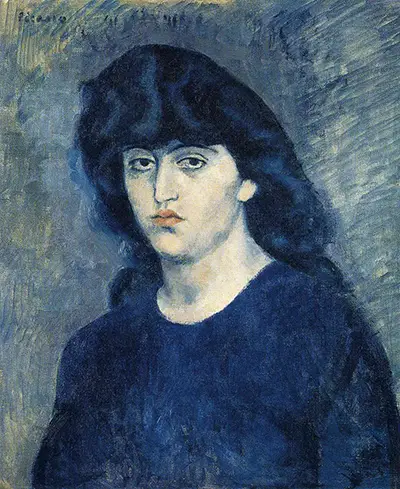The portrait of Suzanne Bloch was painted in Paris in 1904 towards the end of what came to be known as Picasso’s blue period. Picasso lived and worked in Paris during the blue period, 1901 to 1904, was characterised by a sombre looking style and the use of varying shades of blue and green.
Luiz Marques, an eminent Brazilian Art Historian, referred to the portrait as the last of the blue period and while there is some counter debate around this the general consensus is that the portrait largely defines the closure of this part of Picasso’s work.
Picasso was a struggling artist at this period in his life and we can see that his paintings during this period reflected the life and times of those around him. Paintings such as The Old Guitarist and the Blind Man’s Meal highlighted the poverty, hardship and street life of Paris.
The monochromatic fading, half lit colours mirroring a partial life that many of us have or had not seen. Picasso used the theme of blindness and enhanced senses, exploring what we may see when our sight is partial or limited and how it might affect our interaction with our world.
In order to see the world the way the portraits subjects do, we need to look through their eyes. This amplification of the senses and features is a theme that Picasso would return to later on his career with the post-modern Cubism. The Portrait of Suzanne Bloch is certainly in keeping with the style of the blue period but perhaps signifies a change in fortunes of Picasso’s life as he moved into, what would became known, as the Rose period.
The portrait was originally owned by Suzanne Bloch herself until she died at which point it was purchased by the Thannhauser gallery in Munich. Thereafter the portrait was held in a private collection in London, Mechthild Princess Lichnowsky and subsequently with the Biber family in Lugano, Switzerland. After being held with the National Gallery of Art in Washington during WWII, in 1947 it was bought by the Sao Paulo Museum of Art where the portrait is still held to this day.
In 2007 the portrait, worth circa £36m, was stolen from the Sao Paulo Museum of Art only to be recovered, some days later. Three men perpetuated the robbery in what was a theft to order and were reprimanded by the Sao Paulo Police force. Thankfully the painting remained in good condition and was undamaged.
Picasso’s most famous work includes; Guernica (1937) and Les Demoiselles d'Avignon (1907) but his real legacy was perhaps how an artist can transcend paintings as a two dimensional form and influence how we character and shape our own architecture and the world around us.


